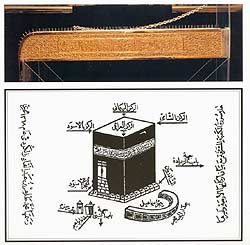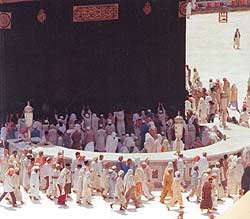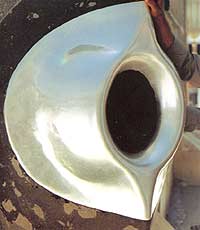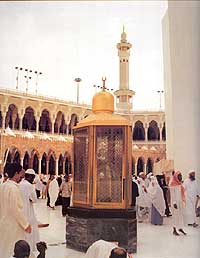>
The Index of the Annexes of the Holy Ka'bah
and its Other Aspects
The Corners of the Holy Ka'bah
The Holy Ka'bah bah has four corners in the following order from the starting point of circumambulation: the Black Stone. the Iraqi corner, the Shami corner (sometimes called AI-Maghrabi corner), then the Yemeni corner. The word rukn means the corner of the Black Stone, and the two corners mean the Black Stone and the Yemeni corners. During the time of Abraham (peace be upon him) there was a semi-circle between the Iraqi and Shami corners in the shape of Hijir Ismail (peace be upon him). There were four corners during the era of Abdullah Ibn AI-Zubair (may Allah be pleased with them), and they were always touched during circumambulation until his death. The four corners were part of the Holy Ka'bah together with Hijir Ismail (peace be upon him). (14, v. 4, p. 121.)
The Skylights of the Holy Ka'bah
There were holes that brought light to the interior of the Holy Ka'bah. Abdullah Ibn At-Zubair fitted four skylights in the roof of the Holy Ka'bah, and another at the gate of the staircase leading to the roof. These skylights had marble frames. and lasted up to the year 843 H., when they were eliminated by AI-Malik AI-Ashraf Bresby in order to protect the Holy Ka'bah from rain. (14, v. 5, p. 38)
The Waterspout of the Holy Ka'bah
The first waterspout was fixed by Quraish when they roofed over the Holy Ka'bah. It was made to drain into Hijir Ismail (peace be upon him). Abdullah Ibn AI-Zubair and AI-llajjaj Ibn Yusuf fitted similar waterspouts. AI-Walced Ibn Abdul Malik added some gilded tin plates to it. Caliphs and wealthy Muslims changed the waterspout several times and the last waterspout was presented by Sultan Abdul Majeed Khan in 1273 H. King Saud (may his soul rest in peace) repaired it and the Custodian of the Two Holy Mosques renovated it. l 1.1. c. 4, p. 85).
|
 |
 |
 |
 |
Hijir Ismail (peace be upon him)
It is the curved section to the north of the Holy Ka'bah on the side of the waterspout. It is called Al-Hateem because a part of it was demolished when Quraish reduced the area of the House while reconstructing it. It is a marbled area with a wall in the form of a .semi-circle with an eastern and a western opening. It is about one and a half metres high, and has three lanterns for lighting and decoration. |
A part of it amounting to three cubits and a hand span is considered as a part of the Holy Ka'bah. It has been renovated more than twenty-five times. It was called the graves of the virgins of Ismail's family. It was said that Ismail (peace be upon him) and his mother Hajir were buried there. It was also said that the spot under the waterspout was a place where supplications were answered. ( 14, v. 3, pp. I 16-122)
AI-Multazam
It is called Al-Muda'a and AI-Mutawwaz. It is the part that lies between the corner of the Black Stone and the door of the Holy Ka'bah. It is the place where Muslims cling to in submissiveness and supplication to Allah, the Almighty. It is said that prayers are answered in this place. (I I. 12)
AI-Mustajar
It is also called AI-Mutawwaz or AI-Mustatjab. It lies between the Yemeni corner and the closed door at the back of the Holy Ka'bah. It is called AI-Multazarn of the elderly of Quraish. It is also a place where supplications are answered by Allah, the Almighty. (I I)
AI-Hateem
Hijir Ismail (peace be upon him) is called AI-Hateem. It also included the area between the Black Stone, Abraham's Station and Zamzam Well. It is the place where sins are forgiven. (1 I )
 |
 |
The Black Stone
This is the site where circumambulation starts, at the south-eastern corner of the Holy Ka'bah. Its origin is the Sapphires of Paradise, its hidden corner is white like the colour of Abrahams Station. It is the place where Muslims repent of their sins and ask Allah's forgiveness. It is a customary practice to touch and kiss it. The Black Stone will be a witness on the Judgement Day to all Muslims who have touched and kissed it in sincerity. It is the spot which has been kissed by the Prophets, Hajj and Umrah pilgrims and visitors. (12, 14, v. 3, pp. 12-31)
|
The Door of the Holy Ka'bah
In the time of Ibrahim AI-Khalil (peace be upon him), the door of the Holy Ka'bah was just a ductless entry. Asa'd Tubba III, one of the Kings of Yemen, erected a single-paneled door that could be locked and opened. Quraish added a double door. Then it was replaced and often decorated several times through history. It had a special key kept by Bani Shaiba and no other people or tribe can possess it, as instructed by the Messenger of Allah (blessings and peace be upon him). During the reign of King Saud (may his soul rest in peace), the present dimensions of the door were established: 318 centimetres high, 171 centimetres wide. It is elevated 222 centimetres from the floor of Al-Shadhrwan. (13, 14)
AI-Mea'jan
It is a small pit adjacent to the wall of the Holy Ka'bah on the eastern side between the Iraqi corner and the door of the Holy Ka'bah. It was said to be the site of the location of Abraham's Station. During the reign of Omar IN Al-Khattab (may Allah be pleased with him), the temporary site of Abraham's Station was restored to its original place after the flooding of Umm Nahshal. The pit is also the place where the Messenger of Allah (blessings and peace be upon him) performed prayer on the day of the conquest of Makkah, after leaving the Holy Ka'bah. It is also the place where Gabriel said his prayers. It is permanently closed now because people stumbled while performing tawaf around the Holy Ka'bah, but its place was marked by a square of marble in 1377 H. Opposite to it, there is a square piece of marble inscribed in Arabic but difficult to read. It is called the pit, the well, AI-Akhsaf and AI-Ghabghab. (13, 14, v. 4, p. 126)
The Station of Abraham
(peace be upon him)
The Station of Abraham (peace be upon him) is considered as one of the appendages of the Holy Ka'bah and the Holy Mosque. It is the stone on which Abraham (peace be upon him) stood while building the Sacred House. His footprints are still visible there. This is one of Allah's permanent, Divine miracles. It is a place of forgiveness of sins for those who say their prayers behind it. The Holy Qur'an says that it should be taken as a place of prayer.
|
 |
 |
AI-Shadhrwan
It is the skirting round the bottom of the wall of the Holy Ka'bah at the level of the circumambulation. Its base is rounded in marble on three sides except the side of Hijir Ismail (peace be upon him). It is most probably a part of the Holy Ka bah. Rings were fixed on it to tie the cloth of the Holy Ka'bah. It was first constructed by Abdullah Ibn Al-Zubair (may Allah be pleased with them) to strengthen the building and prevent water leakage to the foundations. It has been reconstructed and renovated several times. (13, 14)
Mastabat AI-Hirasah
This is the dais of the Holy Ka'bah It has been established next to the Black Stone, with underground air-conditioning. A guard stands on it to oversee people kissing the Black Stone.
The Support Beams Inside the Holy Ka'bah
They are the three wooden pillars that support the two ceilings of the Holy Ka bah. They were erected by Abdullah IN AI-Zubair (may Allah be pleased with them). The diameter of each pillar is about one cubit, and the distance between every two pillars is 2.35 metres.
The Pit of the Holy Ka'bah
The pit is situated to the right of the entrance of the Holy Ka'bah. It was three cubits deep. Inside it, Abraham (peace be upon him) deposited all gifts given to the Holy Ka'bah. It remained until the era of Abdullah IN Al-Zubair (may Allah be pleased with them). It was filled in at that time and the coffer of the Holy Ka'bah was transferred to the house of Shaibah Ibn Othman Ibn Abu Talha. The coffer was later replaced by hooks and hangers for the gifts to the Holy Ka'bah.
|
